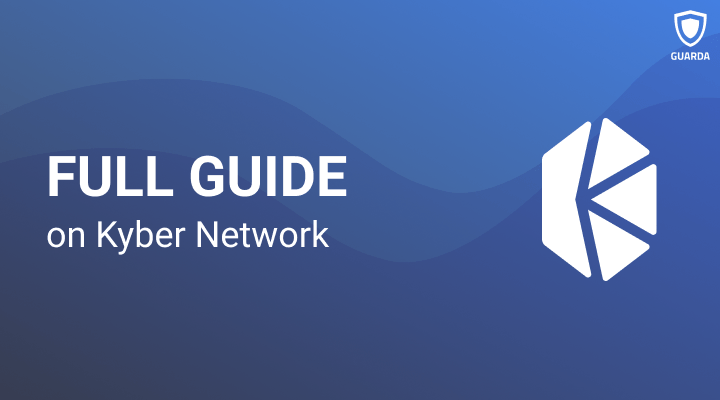Guide on Kyber Network

What is the Kyber Network?
Kyber Network is an ethereum-based protocol specially designed to provide liquidity and facilitate exchanges for ERC-20 tokens. It is a decentralized exchange created in Singapore by co-founders Loi Luu, Yaron Velner, and Victor Tran. The trading platform has a token called Kyber Network Crystal (KNC).
Kyber Network allows users to exchange digital assets instantly. The platform also allows users to conduct multi-asset conversations.
To keep exchanges fast and cheap, they have set up a dynamic backup group to secure the network. This pool is under the control of a Kyber smart contract.
Who’s behind it?
- Loi Luu, CEO, and Co-Founder — A veteran of Blockchain who developed different projects in the past. He developed Oyente, the first open-source security analyzer for intelligent contracts from Ethereum. He was co-founder/developer of SmartPool, a decentralized mining group project. Loi is a Ph.D. candidate in computer science at the National University of Singapore.
- Yaron Velner, CTO, and co-founder — Yaron holds a Ph.D. in computer science from Tel Aviv University. He has over ten years of experience in software engineering and was also a co-founder/developer of SmartPool.
- Victor Tran, Lead Engineer, and Co-Founder — Victor is a back-end engineer and Linux systems administrator with experience in infrastructure development for social marketing and advertising networks. He co-founded and was the CTO of several social marketing start-ups. He was also a developer at SmartPool.
How does it work?
Before trading on this platform, KyberNetwork reserves must pre-purchase and store KNC (KyberNetwork Crystal) tokens. In each transaction, a small fraction (the exact numbers are TBD) of the trade volume will be paid for the reservation to the KyberNetwork platform on KNC. This small fee represents the payment of the reservation to KyberNetwork, in exchange for the right to trade and make profits from trading activities on KyberNetwork. Any KNC tokens left after paying for the feeds will be burned, i.e., taken out of circulation and will cease to exist forever.
Token distribution and fundraising
A maximum of 226,000,000 KyberNetwork Crystal (KNC) tokens were issued. The distribution of the tokens is as follows: 19.47% for the company, 19.47% for founders, advisors, and seed investors, and 61.06% for the public from our private sale and public sale.
Key technologies of Kyber Network
One of the key issues to highlight in Kyber is the reserves that provide liquidity to the actors that are part of its protocol. Kyber acts as its liquidity provider and allows third parties to enter through three types of reserves; It is an immediate source of liquidity for token swaps. Takers as DApps, traders, and wallets that are integrated into the protocol have the counterpart that allows them to convert one token to another without having the risk of low liquidity reserves.
Reserve managers can manage token prices, very different from Uniswap, where estimates are created under a single algorithm, which is an incentive to attract various participants with their trading strategies, as already mentioned, professional market makers, projects that want to list their tokens, developers and token-holding users who are looking for a passive income from their assets.
The types of reserve in Kyber are:
- Price Feed Reserve (PFR)
- Automated Price Reservations (APR)
- Bridge Reservations (DEXes)
How To Store KNC?
Since KNC is an ERC-20 token, it’s compatible with any Ethereum wallet. KNC wallet in Guarda is the easiest way to store and manage it without having to worry about safety or privacy. You can even manage KNC coin through a browser interface or download a desktop app available for macOS, Windows, and Linux. Guarda wallet supports well over 45 coins and is compatible with all ERC-20 tokens, BEP-2, ERC-721, TRON tokens (TRC10 and TRC20), WAVES, ATOM, OMNI, EOS, etc.
Roles in the Kyber Network
There are different roles within the Kyber Network that you should know about:
Users: They send and receive tokens to and from the network. They can be individuals, merchants, or smart contract accounts.
Reserve Entities: They bring in cash to the platform. They can be internal or hosted by a registered third party. They can be classified as public or private depending on whether or not the public contributes to their reserves.
Reserve Contributors: Provide funds to Reserve Entities. They are only associated with public reserve entities and share the profits of the reserve.
Reserve Administrator: Maintains the reserves, calculates the exchange rates, and posts them to the network.
Kyber Network Operator: Adds/removes the Entity Reserves and controls which tokens are listed. Initially, the Kyber team will be responsible for this role, but eventually, it will change to a decentralized government.